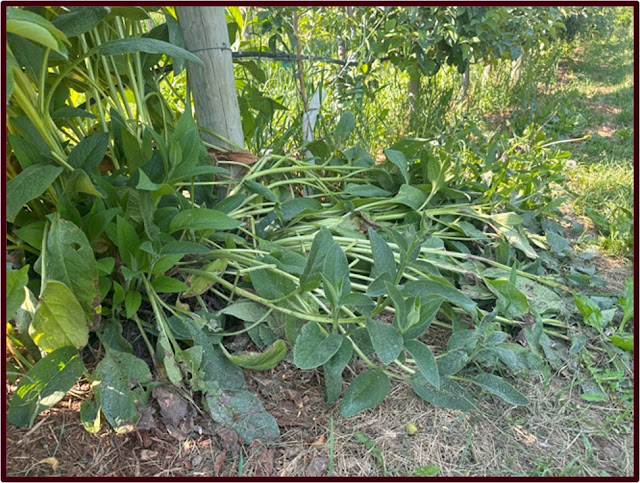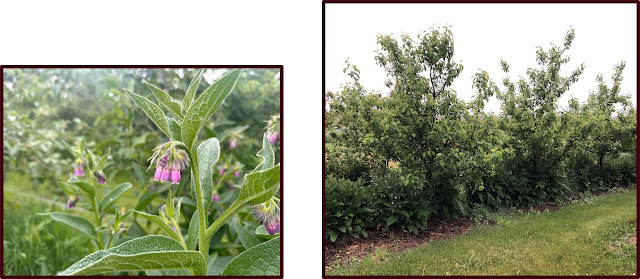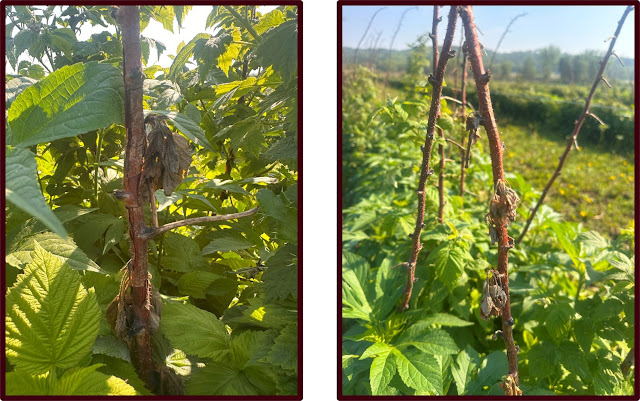Madeline Wimmer- UMN Fruit Production Extension Educator
Apples:
Site-specific strategies: Bocking series comfrey orchard ground cover
Images: Flowering Bocking 4 comfrey at Alternative Roots Farm (left) and an apple tree row with Bocking 14 comfrey before it collapses into a mat (right; photo by John Knisley of Alternative Roots Farm, New Ulm, MN).
Conventional herbicides are commonly used to manage grass and broadleaf plants under orchard understories in conventional vineyards, but these products also come with their own drawbacks and limitations, and are not allowed under USDA Organic production.
A number of options exist to control unwanted vegetation (i.e., weeds) underneath a tree row in an orchard, which can be an alternative to conventional herbicide products. Non-chemical ground management options can be integrated with conventional programs to reduce herbicide inputs, or as an alternative to conventional herbicide programs altogether. These practices can be integrated with one another and include mowing, mulching, cultivation, strategic livestock integration, and establishment of an in-row ground cover.
This topic and a number of these practices were overviewed in a previous webinar from the UMN Fruit Program:
Organic Weed Management: Organic Commercial Fruit Production Strategies for the Midwest
Many non-chemical ground management practices go further by contributing to soil nutrition as mulches and ground covers decompose, for example, or influencing other factors like soil moisture retention. Some methods work better for smaller orchards based on factors like monetary costs or the time and effort required to do it effectively.
Establishing an under-the-tree ground cover can help with weed management and can be tailored to individual site goals. Most cover crops are seeded to cover as much ground as quickly as possible in order to outgrow competing weeds. When these crops are mowed or begin to decompose, they contribute to the soil nutrition profile, and some crops like white clover specifically fix and contribute nitrogen.
Bocking series comfrey (Symphytum x uplandicum)
 Image: Bocking 4 comfrey collapses after flowering as seen in this photo taken at Atoms to Apples Orchard in Mt. Horeb, WI. The grower in this orchard planted comfrey at the end of some of the apple orchard rows, planted as high density.
Image: Bocking 4 comfrey collapses after flowering as seen in this photo taken at Atoms to Apples Orchard in Mt. Horeb, WI. The grower in this orchard planted comfrey at the end of some of the apple orchard rows, planted as high density.
Comfrey (Symphytum spp.) is an herbaceous perennial genus that generally thrive in temperate climates, and grow well in full sun to partial shade environments. There are many different species, but not all are recommended as a ground cover in agricultural settings. For example, common comfrey (Symphytum officinale) is usually avoided because of the number of seeds it disperses, making it a non-native aggressive spreader.
Common comfrey's growth habit is much different than the Bocking series (Symphytum x uplandicum), which is a series of comfrey hybrids, sometimes referred to as Russian comfrey, and includes specific known cultivars such as Bocking 4 and Bocking 14. Both example varieties are sterile and do not spread by seed. The plants grows in a clumped fashion and tend to not spread vegetatively unless its roots are disturbed (e.g., root cuttings). Because it flowers throughout the season it can attract pollinators for certain durations, which is something to be aware of when planning insecticide applications.
This summer, I visited Alternative Roots Farm in New Ulm, MN, to see how they incorporated Bocking 4 into their orchard, where they grow both free-standing and trellised apple trees for fresh market and hard cider production. Alternative Roots Farm mentioned they usually plant it within 1-2 years of planting most of their apple trees. They also mentioned their past experience trying out a number of different plants as an understory crop and have continued to use comfrey as a prominent choice for understory management.
In permaculture literature, Bocking comfrey is often described as a dynamic accumulator—meaning it accumulates a high threshold of a specific nutrient—due to its deep taproot. However, peer-reviewed studies confirming its ability to mine subsoil nutrients compared to other perennials are limited at this time.
Updated on June 16 to correct an error in the original text, which incorrectly referenced the Bocking 14 comfrey cultivar. Bocking 4 was the intended reference grown at Alternative Roots Farm in New Ulm, MN.
Apples:
- Site specific strategies: Bocking series comfrey orchard ground cover
- Growth update: Bloom
- Update on diseased canes in SE Minnesota
Apples
Site-specific strategies: Bocking series comfrey orchard ground cover
Images: Flowering Bocking 4 comfrey at Alternative Roots Farm (left) and an apple tree row with Bocking 14 comfrey before it collapses into a mat (right; photo by John Knisley of Alternative Roots Farm, New Ulm, MN). Conventional herbicides are commonly used to manage grass and broadleaf plants under orchard understories in conventional vineyards, but these products also come with their own drawbacks and limitations, and are not allowed under USDA Organic production.
A number of options exist to control unwanted vegetation (i.e., weeds) underneath a tree row in an orchard, which can be an alternative to conventional herbicide products. Non-chemical ground management options can be integrated with conventional programs to reduce herbicide inputs, or as an alternative to conventional herbicide programs altogether. These practices can be integrated with one another and include mowing, mulching, cultivation, strategic livestock integration, and establishment of an in-row ground cover.
This topic and a number of these practices were overviewed in a previous webinar from the UMN Fruit Program:
Organic Weed Management: Organic Commercial Fruit Production Strategies for the Midwest
Many non-chemical ground management practices go further by contributing to soil nutrition as mulches and ground covers decompose, for example, or influencing other factors like soil moisture retention. Some methods work better for smaller orchards based on factors like monetary costs or the time and effort required to do it effectively.
Establishing an under-the-tree ground cover can help with weed management and can be tailored to individual site goals. Most cover crops are seeded to cover as much ground as quickly as possible in order to outgrow competing weeds. When these crops are mowed or begin to decompose, they contribute to the soil nutrition profile, and some crops like white clover specifically fix and contribute nitrogen.
Bocking series comfrey (Symphytum x uplandicum)
Comfrey (Symphytum spp.) is an herbaceous perennial genus that generally thrive in temperate climates, and grow well in full sun to partial shade environments. There are many different species, but not all are recommended as a ground cover in agricultural settings. For example, common comfrey (Symphytum officinale) is usually avoided because of the number of seeds it disperses, making it a non-native aggressive spreader.
Common comfrey's growth habit is much different than the Bocking series (Symphytum x uplandicum), which is a series of comfrey hybrids, sometimes referred to as Russian comfrey, and includes specific known cultivars such as Bocking 4 and Bocking 14. Both example varieties are sterile and do not spread by seed. The plants grows in a clumped fashion and tend to not spread vegetatively unless its roots are disturbed (e.g., root cuttings). Because it flowers throughout the season it can attract pollinators for certain durations, which is something to be aware of when planning insecticide applications.
The timing of when an orchard decides to plant comfrey may depend on how large the comfrey is when its planted (cutting vs potted plant), grow site factors, and how vigorous the trees are at planting, among other site specific factors. Under trees, these plants can grow over three feet tall before collapsing, at which point, more shoots are regenerated from its base. When the plants collapse, they create a mat that blocks out light and helps to suppress weeds. Because of the wide amount of coverage that happens when the comfrey collapses, it is not always densely planted. As the aboveground vegetation breaks down over time, it also contributes to the soil surface.
This summer, I visited Alternative Roots Farm in New Ulm, MN, to see how they incorporated Bocking 4 into their orchard, where they grow both free-standing and trellised apple trees for fresh market and hard cider production. Alternative Roots Farm mentioned they usually plant it within 1-2 years of planting most of their apple trees. They also mentioned their past experience trying out a number of different plants as an understory crop and have continued to use comfrey as a prominent choice for understory management.
In permaculture literature, Bocking comfrey is often described as a dynamic accumulator—meaning it accumulates a high threshold of a specific nutrient—due to its deep taproot. However, peer-reviewed studies confirming its ability to mine subsoil nutrients compared to other perennials are limited at this time.
It’s helpful to keep in mind that many plants accumulate nutrients, but no nutrients will be added that don’t already exist in some level of the soil. Beyond minerals, comfrey and other plants contribute organic matter to the surface, making this practice more about nutrient cycling or reallocation. As every practice has its strengths and weaknesses, tall understories can also lead to less air flow and high humidity, which is why it's helpful that Bocking comfrey collapses, and why some growers choose to chop or mow comfrey and other understory crops before they get too large.
Resources:
Grapes are entering bloom in warmer Minnesota regions. Grape flowers are wind pollinated, and most cold climate grapes have perfect flowers (i.e., flowers with both male and female parts) that are self fertile. A variety that does not have a perfect flower is St. Pepin (Seyval blanc × MN 1087), which requires nearby cultivars to act as pollinizers for its fruit set.
Resources:
- Comfrey (University of Wisconsin)
- New findings further the study of dynamic accumulators (Cornell Small Farms Program)
- Dynamic Accumulator Database (Cornell and collaborators)
Grapes
Growth stage: Bloom
Image: Brianna is an early harvest cultivar that was observably further ahead in its bloom period than Marquette and Itasca in this vineyard located near Eyota, MN (Zone 5a).The modified E-L system describes bloom in several stages based on the percentage of flower caps that have fallen off, which exposes the actual grape flower and allows for pollination. For example, the above photo shows the cold hardy variety Brianna at around 80% bloom.
It is common to apply a fungicide when the flower caps begin to drop, and recommended when frequent rain events occur during bloom. The Midwest Fruit Pest Management Guide flags downy mildew and botrytis bunch rot as two diseases that are important to manage during this time, which should be considered for vineyards that have historically had high pressure for these diseases. The guide also recommends avoiding back-to-back applications of a fungicide from a single class (i.e., FRAC 3, 7, 11) to slow the development of fungicide resistance. For more information, refer to the Midwest Fruit Pest Management Guide starting on page 163.
 Images: As primocanes continue to grow in a field where a raspberry cane disease was observed in 2024. Shoots emerging from diseased canes are concentrated at the lower half of the floricanes, with many dying after emergence.
Images: As primocanes continue to grow in a field where a raspberry cane disease was observed in 2024. Shoots emerging from diseased canes are concentrated at the lower half of the floricanes, with many dying after emergence.
Earlier this year, I wrote about a summer-bearing raspberry stand in southeastern Minnesota that was impacted by a raspberry cane disease the previous growing season. Symptoms observed at the beginning of the growing season on the floricanes were cracks and discoloration on the canes.
Now that the season has progressed, a number of shoots have emerged from the floricanes with many dying back—a symptom similar to the raspberry cane disease known as spur blight (Didymella applanata). Based on these symptoms and depending on future weather events, there is a chance for the disease to spread to new primocanes.
Practices that can help prevent cane disease involve increasing air circulation throughout the canopy, which can sometimes be achieved by trellising and thinning out dense patches. It’s also recommended to remove wild raspberries near a growing site as they can be a source for the disease.
Resources:
This article may be shared for educational purposes with attribution to the University of Minnesota Extension. For other uses, please contact UMN Extension for permission.
It is common to apply a fungicide when the flower caps begin to drop, and recommended when frequent rain events occur during bloom. The Midwest Fruit Pest Management Guide flags downy mildew and botrytis bunch rot as two diseases that are important to manage during this time, which should be considered for vineyards that have historically had high pressure for these diseases. The guide also recommends avoiding back-to-back applications of a fungicide from a single class (i.e., FRAC 3, 7, 11) to slow the development of fungicide resistance. For more information, refer to the Midwest Fruit Pest Management Guide starting on page 163.
Raspberries
Update on diseased canes in SE Minnesota
Earlier this year, I wrote about a summer-bearing raspberry stand in southeastern Minnesota that was impacted by a raspberry cane disease the previous growing season. Symptoms observed at the beginning of the growing season on the floricanes were cracks and discoloration on the canes.
Now that the season has progressed, a number of shoots have emerged from the floricanes with many dying back—a symptom similar to the raspberry cane disease known as spur blight (Didymella applanata). Based on these symptoms and depending on future weather events, there is a chance for the disease to spread to new primocanes.
Practices that can help prevent cane disease involve increasing air circulation throughout the canopy, which can sometimes be achieved by trellising and thinning out dense patches. It’s also recommended to remove wild raspberries near a growing site as they can be a source for the disease.
Resources:
- Raspberry cane diseases (UMN)
- Spur blight of red raspberries (Ohio State University)
This article may be shared for educational purposes with attribution to the University of Minnesota Extension. For other uses, please contact UMN Extension for permission.

Comments
Post a Comment